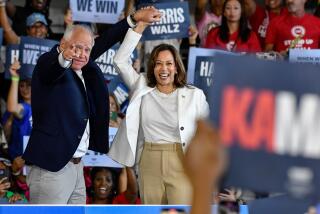Labor Group Takes $40-Million Aim at Midterm Elections
WASHINGTON â Leaders of the nationâs largest labor federation announced Wednesday that they would spend more money this year than ever before to get voters to the polls in a midterm election they hoped would return Democrats to power in Congress.
âThis Labor Day, it appears that a âperfect stormâ is gathering that may well sweep away Republican control of the Congress this fall,â said AFL-CIO President John J. Sweeney.
Republican voter mobilization efforts were credited with big GOP wins in 2004 and 2002. With voter discontent rising, Democrats are hoping to regain ground this fall, and labor unions -- the traditional backbone of Democratic voter organizing -- are expected to play a critical role.
Karen Ackerman, political director of the 9-million-member AFL-CIO, said the federation would spend $40 million on its voter turnout effort this year, compared with $35 million in the last congressional midterm election.
âThis election, as everyone knows, is about turnout,â Ackerman said. âIn many cases, we may well prove to be the decisive factorâ in hard-fought races.
Tracey Schmitt, spokeswoman for the Republican National Committee, said the GOP was not worried.
âBuilding on our success from 2004, we are running a massive voter turnout operation that is as precise as has ever been seen in American politics,â Schmitt said. âWe know it works, and we have been fine-tuning our tactics to ensure we get our voters to the polls on election day.â
Last year the AFL-CIO suffered the defection of seven member unions -- including the nationâs largest, the Service Employees International Union, which formed a rival coalition called Change to Win. But both groups said the split would not damage voter mobilization efforts, because they were cooperating in many regions of the country to support their preferred candidates, nearly all Democrats.
âIn some places, weâre working very closely together, and in other places weâre working on parallel tracks,â said Carole Florman, communications director of Change to Win. âYou have a very complex landscape but a shared goal of working to help candidates who will stand up for working families.â
The two labor groups each released polling data that reached similar conclusions: That economic issues such as wage stagnation, healthcare costs and gasoline prices will be more important than the Iraq war in spurring Democratic and swing voters to go to the polls.
âEconomic trends have strained working families to the breaking point,â Sweeney said. âWorkers are not sharing in the wealth they helped create, and our nationâs economic recovery has not been a recovery for workers at all.â
The role of labor unions in Democratic turnout has been somewhat exaggerated in past elections, said Charles Cook, a nonpartisan political analyst who publishes the Cook Political Report. Moreover, Cook predicted that no matter which party was better organized, the critical factor would not be how many voters went to the polls, but how many voters did not.
âMy hunch is that in this election, the bigger story is whether disillusioned Republicans stay home,â Cook said. âI think Republicans are going to be faced with having a terrific organization and a disillusioned electorate.â
Cook also noted that Democrats didnât seem as well organized as they were in the 2004 presidential election. For that campaign Democrats formed an umbrella group called America Coming Together to coordinate voter mobilization efforts. This time, there is no umbrella group and the labor and party efforts are directed independently.
âWhat they are doing is putting together a patchwork,â Cook said.
Sen. Charles E. Schumer (D-N.Y.), head of the Democratic Senatorial Campaign Committee, said improved Democratic field operations for getting out the vote would help deliver control of Congress to his party. He noted that Republicans had been especially successful recently in the final days before the polls open, running â72-hourâ operations to get out the vote.
âOne of the ways that they have won elections at the last minute is in terms of field operations,â Schumer told reporters this week. âWe have planned a detailed field operation for the last year and a half in many of the battleground states.â
Times staff writer Noam N. Levey contributed to this report.
More to Read
Get the L.A. Times Politics newsletter
Deeply reported insights into legislation, politics and policy from Sacramento, Washington and beyond. In your inbox three times per week.
You may occasionally receive promotional content from the Los Angeles Times.










